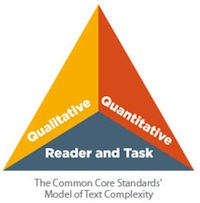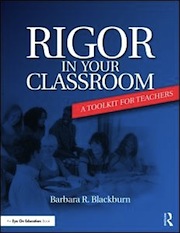Relating Text Complexity to Rigor in the Classroom
 By Barbara Blackburn
By Barbara Blackburn
As we work to both support students and achieve rigor in our classrooms, the Common Core’s focus on encouraging students to read increasingly challenging texts across the curriculum is very much in play.
The Common Core Standards add text complexity as a dimension of literacy. To establish text complexity, the standards propose a three-pronged system:
1. Quantitative indices such as information on the number of infrequent words and length of sentences (e.g., automatic readability programs);
 2. Qualitative analyses of features such as levels of meaning (e.g., readers need to make inferences to understand a character’s motive); and
2. Qualitative analyses of features such as levels of meaning (e.g., readers need to make inferences to understand a character’s motive); and
3. Reader-task variables such as readers’ background knowledge of a text’s topic and ways in which teachers and situations influence readers’ interactions with a text (e.g., an audio of a book or the level of teacher guidance).
Let’s turn our attention to each of these factors, in order to more fully understand them.
Quantitative Factors
When evaluating text complexity, there are quantitative factors to consider. These are the items that readability formulas measure. Readability formulas typically use characteristics such as sentence length and word frequency to determine difficulty of text. However, the quantitative factors are only the starting point in text selection. (I look at quantitative factors in more detail in my new book Rigor in Your Classroom.)
Qualitative Text Features
Let’s look at the qualitative factors in a text. What factors affect the quantitative readability of the text? For example, we should think about the text support features. Are there supporting features within the text that help the reader? These might be pictures, charts, graphs or headings that help organize the reading. It also includes the print size, which makes a text easier or harder to read.
Then we should consider the quality of the text. What is the overall quality of the book? Is it lively and engaging? Is it of enduring literary quality? Are there deeper levels of meaning within the text such as literary allusions? A student might be able to read The Old Man and the Sea, but would think it is a book about an old man and a fish. Understanding the metaphorical nature of the book is a qualitative piece of evaluation.
Reader-Task Factors

- Are you looking for a book to read aloud or provide via audio to students? If so, pick a book that is more difficult than the students’ reading level, since their listening vocabulary is typically higher that their reading vocabulary.
- Are you looking for a book for instruction where you plan to provide support? You might choose a book at, or close to, their reading level, since 75% accuracy and comprehension at their instructional level.
- Are you looking for a book for fluent reading, where students independently read a book with 90% accuracy for added confidence and fluency? Then, choose a book below their reading level.
- In the case of self-selection of books, are you looking for a book for information or pleasure? Usually, you pick an easier book for pleasure.
Next the reader brings a variety of important factors to the reading experience. There are four important areas to consider:
- Reading ability, which can be measured in a variety of ways. This helps you understand how much support will be needed for the student to read the text.
- Prior knowledge is the student’s background knowledge about the subject. A lack of prior knowledge can negatively affect the reading experience.
- Interest level determines reader commitment. If the reader is totally uninterested in the subject of the book, nothing else really seems to matter, especially to the reader.
- Finally, developmental appropriateness is an important concept. For example, a sixth grader may possess the ability to read Silas Marner, but, from a developmental appropriateness view, that book may not be the best choice for that student. Conversely, an older student with limited reading abilities is often turned off by books that he or she is able to read, but that they perceive as too childish.
Don’t rely solely on quantitative tools
All the factors within the major areas are important considerations when evaluating the appropriateness of a text for a reader. However, it is easy to rely solely on the quantitative measures, since many books and other texts are labeled with those levels. Remember: balance the quantitative with the qualitative features of the text, as well as consider your students’ needs, in order to make the best choice.

Barbara Blackburn’s latest book, Rigor in Your Classroom: A Toolkit for Teachers, was published in May 2014 by Routledge/Eye on Education.



































